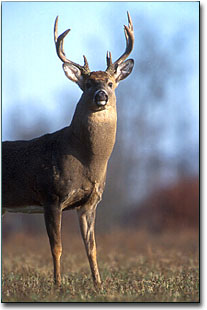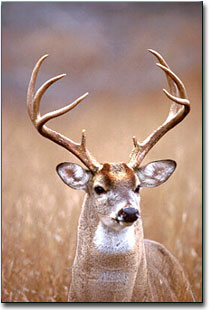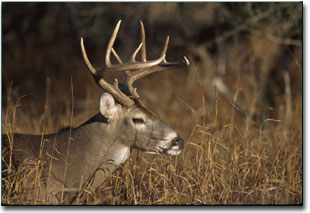|
The Camera Hunter®
Photography and Text Copyright Bill Silliker, Jr.
All rights reserved.

To Catch A Deer
Wrapped in a camouflage cloth, I sat on the ground along the edge of the woods watching the still dark field and wondered: would he come out again this morning? If he does, where? Was I on the wrong side of the field? If so, it would be a long shot. But with the wind direction there was no other choice to avoid having my scent blown towards the wary white-tail.
What if the ambush was too close to where the big guy comes out? He'll surely catch scent then, no matter the wind direction or how well the camouflage cloth blended with the forest.
Too late to worry about any of this now, I told myself. Just sit tight and wait for the rising sun. And hope that you guessed correctly.
After watching the big buck emerge from the thick hardwood forest three mornings in a row, I was pretty sure that I had him patterned. But with a mature white-tailed deer buck, you never know. Since the rut was about to begin, the odds increased that he'd show himself again. This buck had been checking does as they fed along the edge of the field for three days to see if any were ready to mate. But would he again this morning?
The sky lightened to the southeast and the field became more visible. The first doe slipped out of the woods and began to feed. Another doe arrived, then another.
A larger deer showed in the blackness of the tree line. Was it a buck? I peered hard through the telephoto lens set on the tripod in front of me but couldn't tell.
The big deer stepped out into the field, away from the safety of the trees. As he did, his large rack of antlers reflected the glow from of the rising sun. It was him - the dominant buck!
He was almost close enough for photography. Should I risk a few shots? The light still wasn't that great. And the sound of the camera's shutter might spook one of the does, if not the big guy.
I decided to wait.
As the light got better, one of the does came towards me, peering intently. The slightest motion can give away your presence to a white-tail when you're in a ground ambush. Had she seen the telephoto lens move when I watched the buck? Or did she just decide that the blind looked out of place?
I never got the chance to find out. Just then the big buck ran towards the doe. She scampered towards the woods not fifty feet from where I sat, holding my breath.
She disappeared, but he stopped at the spot where she had last stood while making the most wonderful of poses in the sweet light of early morning.
Target Your Species
The pursuit of wildlife with a camera often seems to involve waiting in the wrong place. While discovering ways to improve your ability to sit still does help, it really makes more sense to do your waiting in the best possible places. The key to doing that is to target a species at a time. You can still shoot anything that gets within camera range, but your camera hunt will be a lot more productive if you plan for a single species before you step out the door. That will enable you to invest your time where those critters are most apt to be during the daylight hours.

Of course to do that, you need to know something about your target species. And so the wildlife photographer can learn a lot by applying some of the methods used by expert traditional hunters.
You already know that white-tailed deer are wary animals, especially during hunting season. Some might think that the pros use mega-telephoto lenses to handle such critters. Not so. In fact, my First Rule of Wildlife Photography says that no telephoto lens exists that can offset a lack of technique in getting close to the critters. With a white-tailed buck during the firearms season, that's especially true. You need to get closer than the average bow hunter to get a picture that really fills the frame, even with a long telephoto lens. To do that you need to get past their extremely acute sense of smell and equally excellent ability to spot any movement. You also can't afford to make any noise.
If you're attempting to still hunt - walk slowly through the woods and stop every few steps to scan for a deer - all of these factors come into play and make it very difficult to get up on one. With still-hunting, the only photo opportunity for a white-tail is often a shot of its east end headed west!
You also need to catch a deer in enough light to adequately record its image on film, something the traditional hunter doesn't have to worry about. Think about it for a moment: when and where do you most often see white-tails? Isn't it usually along the edges of fields, or in the shade of the woods that they use as cover, if not in the woods themselves? And isn't it more often early in the morning or late in the day, when the sun angle is the lowest and its intensity the least?
The good news for the camera hunter is that white-tails don't present much of an exposure setting challenge. Or do they?
Let's look at this most important aspect of camera hunting for a moment. Setting your camera for the right exposure is important because if you don't have the right exposure, you might as well go home. It's sort of akin to firing a rifle at a deer without taking aim. Fortunately, white-tails reflect exactly an average amount of light and will therefore record on film quite well if your camera is set to record an average scene for the amount of light available where the deer is when you take its picture.
The problem comes when the background for your photograph is a lot darker, say that spruce fir forest that your deer is hanging along the edge of. The answer is to meter something of average reflectance in the same light as the deer. Or better yet, if you've got a camera with a spot meter and are close enough to the deer to fill the spot with it, set your exposure accordingly and you'll make a perfectly exposed image.
As for equipment, a 500mm f4 Nikkor lens serves as my prime wildlife lens. It provides 10X magnification without being too heavy to carry around the woods all day. I always use a sturdy tripod to support this lens. And when I have enough light and want some extra "reach", I extend its magnifying power with a very high quality and, unfortunately, very pricey teleconverter. The Nikkor 1.4X makes the prime lens a 700mm, or 14X telephoto.
There is another price exacted when using this teleconverter: it reduces the light reaching the film by one stop. Since you're already fighting a losing battle for light with big bucks, you'll not often use a teleconverter to get "close" to one.

The Big Bucks
Many of the wildlife photographs of deer with big racks that you see are made in places where the deer aren't hunted. That's partly because the professional wildlife photographers who make those images don't have enough time to scour the woods for the years it might take to bag a big buck on film and still put bread on the table.
It's also because trophy animals - be they deer, elk, moose or some other species - just don't come along as often at places where a species is hunted. Anyone who doubts that should take a trip to Yellowstone National Park just to see of the racks on the elk out there compared to the ones you might get lucky enough to see outside the park where hunting is permitted.
It's a fact that white-tails are harder to photograph once the guns start going off in the woods early in the fall. Your problems of getting close to one are compounded, especially depending upon where you go after them with a camera. Even white-tails that hang out at areas where hunting is not permitted sometimes act spooky by November.
If you do choose to camera hunt in or near areas where firearms hunting is permitted, it only makes sense to wear blaze orange. During firearms hunting seasons, it pays to exercise the same common sense precautions required of licensed hunters in the woods. While no true sportsman would fire on a target he wasn't sure of, mistakes can happen. Just because you don't need a license to camera hunt doesn't mean that you should be careless about safety: anyone hiking in hunting areas should wear blaze orange.
One of the best things about camera hunting is that you never have a closed season. The only seasonal imperatives are the biological clock of the species that you pursue and the weather, which can impact on how, when and where you'll find your chosen species.
Some might call it luck. But I know better. It was because I had learned to target a species at a time, studies their habits, learned how to beat their abilities and patterned an individual animal that on that morning, I was waiting in the right place.
Catch yours in the good light.
BS-NPN
Maine wildlife & nature photographer Bill Silliker, Jr. – The Mooseman - photographed at many wild places in North America, with the results published in magazines internationally and in 9 of his own books. Bill was an instructor of wildlife and nature photography for L. L. Bean's Outdoor Discovery Program and a member of the Fuji Film Talent Team. Read more about Bill on the Camera Hunter archives page.


| 


